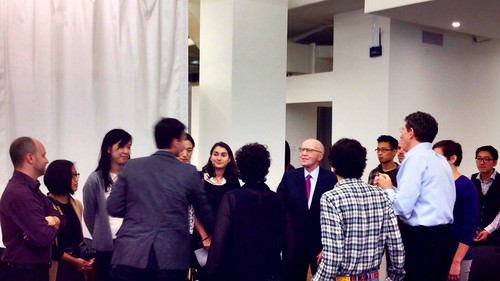(Cornell City and Regional Planning Masters students meet Gerald D. Hines at the Cornell AAP NYC Studio)
This past Thursday was a double header at the AAP NYC studio. Starting at 9AM the graduate planning students and the undergraduate architecture students had a quick visit with Gerald Hines. In town for the Cornell Real Estate conference Mr. Hines came by the AAP studio to discover what this semester’s planning and architecture students have been up to.
The city and regional planning students gave a quick run-through of our research posters showing the accessibility, management/maintenance, intensity, infrastructure, and affordability of Manhattan’s Hudson River and East River waterfronts (specifically between Chambers Street to 34th Street on the West side and Brooklyn Bridge to 34th Street on the East side). Our urban design studio professor, Claire Weisz, facilitated a question and answer session regarding the posters. Mr. Hines also shared with students anecdotes from the real estate development world in NYC and abroad.
 (One of the descriptive graphics I created for the urban design studio. Shows the Hudson River waterfront’s usage changes over a 100 year period.)
(One of the descriptive graphics I created for the urban design studio. Shows the Hudson River waterfront’s usage changes over a 100 year period.)
Dovetailing off Mr. Hines’ visit was a presentation and conversation with Tim McManus, Senior Housing Planner for the New York City Housing Authority (NYCHA). Formerly a planner for Gensler’s Urban Design office in NYC, McManus currently works for NYCHA. He is responsible for executing a broad range of planning assignments, including an “infill initiative” being considered for a number of NYCHA campuses, especially in Manhattan.
For a bit of background, NYCHA is the most robust and largest social housing systems in the United States. While numerous other large metropolises, such as Chicago, have shuttered their housing authorities, NYCHA remains a central pillar in NYC’s affordable housing strategy. Boston, for example, is currently phasing out its social housing. Meanwhile, some 400,000 of NYC’s residents live in NYCHA housing. In total, NYCHA represents roughly 180,000 apartments in nearly 2,600 buildings. If it were its own city, it would be the 21st largest metro in the US.
Much of NYCHA’s funding comes from the Federal government. However, since 2000 annual budget allocations have diminished each year. Consequently, operation and management costs have outstripped funding over the course of the last decade. NYCHA’s proposed strategy to increasing funding to eliminate the funding gap to maintain existing buildings and take care of current resident’s needs is to lease off 14 development sites on existing NYCHA campuses. These site are to be lease for 99 years to developers who will build mixed income housing. The land leases have the potential to increase NYCHA’s annual operating and management budget by tens of millions of dollars annually. The identified sites are predominantly located on surface parking lots— and a few under-utilized green spaces.
Listen to a 15 minute outtake from Tim’s talk here.
This link provides the context for NYCHA’s recent land lease initiative.
http://www.nyc.gov/html/nycha/html/preserving/leasing-land.shtml
See this link for NYCHA’s RFEI and an analysis of the Baruch Site.
http://www.nyc.gov/html/nycha/downloads/pdf/nycha-land-lease-initiative-rfei-appendix-a-8.5×11.pdf

